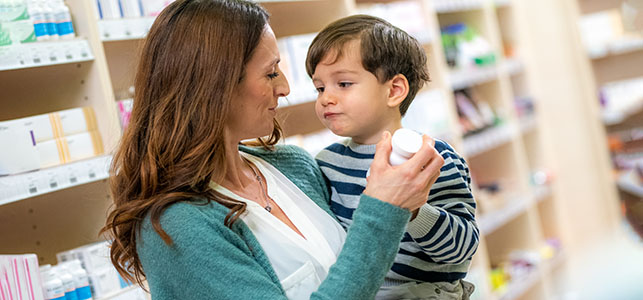
Medication label insight from a pediatric pharmacist
That tiny print on a medicine bottle adds up to important information to keep your child safe and help them get well. While medicine labels may look slightly different, each contains required information that you’ll want to review. Dr. Natalie Nguyen, pharmacist and medication safety manager, explains what to look for and why it’s important.
How to read an over-the-counter drug fact label
Over-the-counter medications (acetaminophen, ibuprofen, etc.) can be purchased at pharmacies, supermarkets and other retail outlets. Every over-the-counter medication has a drug fact label with the following details:
- What the medicine is for – Choose the medicine that’s intended for your child’s specific symptoms. The fewer the number of ingredients and intended uses, the fewer the opportunities for interactions or unintended reactions.
- What’s in it – Giving more than one medication with the same active ingredients can lead to overexposure or overdose. For instance, if you’re giving your child acetaminophen to treat a fever, you want to avoid giving them cold medicine that may also contain acetaminophen to prevent giving extra doses of the same ingredient. Look closely at what’s included in each medicine to avoid overlap.
- When to give it – The directions on the label tell you how often to give the medicine. Set an alarm to remind you when the next available time is to prevent giving the next dose to soon.
- How much to give – The dosage for many children’s medications depends on your child’s weight, but some medications should not be given to children under a certain age.
- Check that you have an accurate measuring device, such as an oral syringe, for liquid medications. A kitchen spoon is not an accurate measuring device. You can ask the pharmacy for a free oral syringe if you do not have one at home.
- For oral liquids or suspensions, double check the concentration (amount of drug per milliliter (mL)) as there may be different concentrations of over-the-counter medications sold for children.
- Warnings – This includes alerts about when not to give the medicine, when to stop the medicine and side effects that may occur. This is especially important information because it can help you prevent a potentially dangerous situation.
The label will also list inactive ingredients so you’re aware in case of allergies, and storage instructions to help maintain the medicine’s stability and effectiveness.
The pharmacist or doctor can provide guidance or answer any questions you may have about over-the-counter medicines specific to your child.
What your child’s prescription medicine label is telling you
Prescription medications need to be ordered by a health care provider and must be dispensed by a pharmacist. This is because these medications require a health care provider to evaluate the health concern, review the appropriateness and ensure safety for the patient. These licensed professionals can review for potential medication interactions/risks and provide proper guidance to make sure the medications are taken safely.
Prescription medication labels contain similar information to what’s listed on over-the-counter labels, with the following additions. These details will help you make sure that you’ve received and are giving your child the correct prescription.
- Patient name and date of birth – The first thing you’ll want to check is that you received the medicine intended for your child.
- Medication name and strength – Compare the name, strength and dosage printed on the label to what was prescribed to make sure they match.
- Description – The visual description such as shape, color and dosage form (for example liquid or tablet) will help you identify what the medicine should look like.
- Quantity and refills – The amount of medication provided will be listed, along with the number of refills remaining before a new prescription is required.
- Prescriber name – The name of the health care provider who prescribed the medicine should be listed correctly.
- Pharmacy contact information – Contact the pharmacy at the number provided, or in person, if you have questions or any of the information printed on the label doesn’t align with what you expected.
Once you’ve reviewed and confirmed the details, it’s time to give your child their medication.
Our child life specialists offer tips to make medicine time go smoothly.
The Children’s Pavilion Pharmacy is here to help!
Did you know there’s a pharmacy in the Children’s Pavilion staffed by specially trained pediatric pharmacists?
In addition to filling prescriptions before you leave your appointment, you can also snag over-the-counter items like saline, ibuprofen and even Pedialyte.
